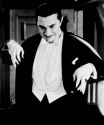
10. Bela Lugosi as Count Dracula (from Dracula, 1931, directed by Todd Browning)
While I haven’t listed my favorite vampires in any particular order, I couldn’t possibly begin any such list without first paying tribute to Bela Lugosi’s portrayal of Count Dracula in Browning’s monumental 1931 film. Browning’s version isn’t necessarily the most faithful adaptation of Bram Stoker’s novel, but it’s one of the most influential, largely due to Lugosi’s performance. His version of the count is dripping with aristocratic masculinity and is adorned with the now famous foppish cape and phallocentric fangs. Lugosi’s hypnotic, ballet-like movements are still strangely alluring and fiendish, and a testament to the uncanny and the animal sexuality buried beneath repressed Victorian society, which Stoker explores in his novel. Of course, Lugosi’s performance will later inform, if not directly inspire, countless vampires from the Hammer films of the 1950s, to Anne Rice’s Lestat, to Gary Oldman’s portrayal of the Count in Bram Stoker’s Dracula.
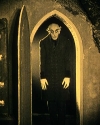
9. Max Schreck as Count Orlock (from Nosferatu, 1922, directed by F.W. Murnau)
I like to think of Murnau’s Nosferatu and Browning’s Dracula as companion pieces. Browning’s film is the more definitive film version of Stoker’s novel, but in some ways Murnau’s version is truer to the original. Murnau never obtained permission to adapt Stoker’s novel, so the names and locations have been changed, but the plot is basically the same. Murnau departs from Browning’s film, however, in that his version of the vampire, Count Orlock, as brilliantly played by Max Schreck, is far more fiendish and infernal than Lugosi’s version. Drawing upon the more monstrous aspects of Stoker’s novel, Orlock is more likely to simply rip out his victim’s throat than seduce. Orlock, in other words, is more devil than dandy. Orlock’s portrayal of the count has been nearly as influential as Lugosi’s. For example, films that emphasize the more monstrous aspects of the vampire and use the creature to build a sense of atmospheric dread, including Salem’s Lot and Carl Dreyer’s 1930 Vampyr, are indebted to Nosferatu. Likewise, the “the Master,” the vampiric antagonist from the first season of the popular television series Buffy the Vampire Slayer, is visually derivative of Orlock’s pale, sickly skin, bat-like ears, and eerily long fingers.
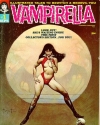
8. Vampirella (created by Forrest J. Ackerman for the 1969 debut issue of the comic book Vampirella)
Ok, I should probably apologize for this one, but I simply can’t help myself. Vampirella is a guilty pleasure. And besides, I’ll wager that while she’s not nearly as influential as the previous vampires from this list, this little vamp from the planet Draculon has still had no small degree of influence. Clad in her iconic red bikini and go-go boots, Vampirella is a comic-book heroine created on the stiletto heels of the 1960s sexual revolution by Forrest J. Ackerman with artists Frank Frazetta and Tom Sutton. Vampirella is emblematic of both sexual empowerment and also shameless exploitation. She has little to do with either Stoker’s novel or the older, folk-based myths of vampirism. Instead, she’s a blend of sci-fi and fantasy action, sex appeal, and lots of kick-ass attitude. Sci-fi vampire action films such as Underworld and the Blade trilogy are in her debt, along with countless b-grade films featuring blood-sucking seductresses.
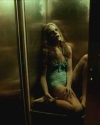
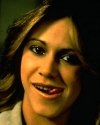
7. Marilyn Chambers as Rose (from Rabid, 1977, directed by David Cronenberg)
Rose is not a traditional vampire. But, then again, Cronenberg is not a traditional director. Rose, played by the pornstar Marilyn Chambers, is critically injured in a motorcycle accident. After a radical procedure involving experimental tissue transplants, she develops a hunger for human blood and grows a fang-like stinger under her armpit that she uses to feed on victims who afterward turn into rabid, diseased zombies. I know what you’re thinking. This is a ridiculous premise. Well, I can’t argue with that. You’re also probably thinking that this sounds more like a zombie film than a vampire film. That’s true enough, but then again Murnau’s vampire did not turn his victims into other vampires. Instead, Count Orlock brought disease and pestilence into each unsuspecting community he infiltrated. Cronenberg’s plot is perhaps needlessly strange and grotesque, but he is drawing upon the fact that vampirism has always been used as a metaphor for disease, especially of the venereal variety. In fact, Bram Stoker suffered from syphilis when he wrote Dracula, and sexually transmitted diseases and prostitution were embarrassing epidemics in his Victorian England. Add a little folklore, plus an interest in the newly developing science of psychology, the phonograph, and other technologies that seemingly transcend the human body, and you have all the ingredients for Stoker’s novel. Likewise, Cronenberg’s films always tend explore the strange and unsettling ways in which human bodies are hybrid engines of flesh, disease and machinery. In Rabid, Cronenberg is simply exaggerating a latent aspect of the vampire myth: human sexuality, with its potential convergences of flesh, disease and invasion, is both pleasurable and frightening. While I don’t think Coppola had Rabid in mind when he directed Bram Stoker’s Dracula, he nevertheless makes a similarly explicit connection between vampirism, technology, and venereal disease.
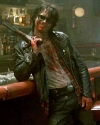
6. Bill Paxton as Severen (from Near Dark, 1987, directed by Kathryn Bigelow)
Vampires have traditionally been used as social metaphors. The vampire myth has been used to explore a decadent aristocracy that feeds upon its subjects, the infernal and devilish aspects of humanity, sexual repression or hostility, and countless other social ills. In Near Dark, the vampires are a violent family of misfit outsiders who cruise, booze, and kill their way through America’s heartland. After being bitten by one of the more placid members of the vampire gang, the doe-eyed Caleb Colton must choose between his mundane, small-town life and his vampire-girlfriend’s savage but libertine lifestyle. The vampires, in other words, represent the lure of sex, drugs, and gang violence. This was something of a national obsession in the “just say no” 80s, as evident in the host of other vampire films with similar social commentary, namely The Lost Boys, The Hunger, and, with much more camp and parody, Fright Night. Near Dark has an impressive ensemble cast, including Lance Henriksen (Pumpkinhead), Jenette Goldstein (Aliens), and Adrian Pasdar (Heroes). It also features the best bar scene in all of vampire film history. Everything about the scene is brilliant, from the irresistible turn-the-tables-on-the-bar-thugs dynamic, to the over-the-top violence, to the funky bar top dancing. If this weren’t enough, the entire scene is punctuated by some really great rock-n-roll gems from the 80s, including John Parr’s “Naughty, Naughty” and The Cramps’ “Fever.”
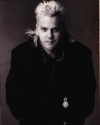
5. Kiefer Sutherland as David (from The Lost Boys, 1987, directed by Joel Schumaker)
In my opinion, The Lost Boys is terrific, but not quite as good as Near Dark. It’s a bit cutesier and less visceral than Near Dark, even though it has a similar tone and theme. However, Sutherland is impressive as David the vampire, a literal bad boy from hell who symbolizes rebellion, a youth culture gone wild, and old-fashioned rock and roll fun. Michael is the new kid in town, played by Jason Patrick, and is bitten by Star, a member of David’s vampire gang. The two fall in love and Michael must therefore choose between a life of violence and indulgent excess or the quiet and boring middle class life being offered by his grandfather and mom. As other 80s films such as Once Bitten and Vamp attest, it just ain’t easy being a teenager in love, especially if you’re in a vampire film. All of the actors in The Lost Boys are first-rate, but I think the indefatigable Frog brothers, played by Corey Feldman and Jason Newlander, are the real heart and soul of this movie. I’m always charmed by their inept, homemade crossbows, super soakers full of holy water, and steel-jawed, deadpan assurance that comic books might just save your life. This film is also a chance to see the Corey’s Haim and Feldman together in their prime before they both became rather sad has-beens. As with Near Dark, this film also features a truly fantastic soundtrack with songs by INXS, Lou Gramm, Echo and the Bunnymen, and Roger Daltry. Gramm’s “Lost in the Shadows” sends me happily back to the 80s every time I hear it.
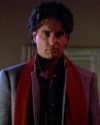
4. Chris Sarandon as Jerry Dandridge (from Fright Night, 1985, directed by Joel Schumaker)
Jerry Dandridge is one silky-smooth vampire. He doesn’t sneak or creep into a room; this vampire virtually sambas his way to his victim’s throat like an undead Ricardo Montalban. The 80s were a golden age of vampire films and Fright Night, like Near Dark and The Lost Boys, explores the darker aspects of the Reagan era. But this time the societal problem is not gang violence or drugs, but the dangers of disco dancing. Young Charley Brewster, played by William Ragsdale, learns how dangerous disco can be when he loses his girlfriend to the evil Jerry Dandridge after his impressive nightclub performance. But when not charming the pants off helpless girls on the dance floor, Dandridge does manage to be a respectably formidable vampire, and Sarandon plays the part with an appropriate amount of aggression, sex appeal, and camp. Stephen Geoffrey, however, nearly steals the movie with his performance as “Evil” Ed Thompson, the misunderstood and wonderfully weird sidekick to Brewster. Roddy McDowall is also impressive as Peter Vincent, a washed up actor and host of the eponymously named television show Fright Night. Vincent is a tribute to Vincent Price, Peter Cushing, and the golden age of vampire films. In fact, the entire dynamic and tone of the film is such that you’ll find it utterly irresistible if you’re like me and spent your Saturday nights as an adolescent staying up way too late watching vampire movies.
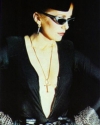
3. Catherine Deneuve as Miriam Blaylock (from The Hunger, 1983, directed by Tony Scott)
The plot of The Hunger involves a bizarre love triangle, perverse sexual appetite, and more disco dancing. Apparently, being bitten by a vampire in the 80s meant catching a nasty case of boogie fever. In The Hunger, the vampiress Miriam prowls the Manhattan club scene in search of prey, promising them an eternity of beauty, sex, and a goth-glam lifestyle in New York’s seedy but fashionable circles. But there’s a catch. The party never ends only for Miriam, as her victims eventually wither into grotesque, corpse-like figures doomed to spend eternity in perpetual old age. As with all vampire films in the 80s, The Hunger is a cautionary tale against indulgence and excess, but it is also notable for placing less emphasis on blood and gore and instead harking back to moodier, more expressionistic vampire films such as Dreyer’s Vampyr and Murnau’s Nosferatu. The Hunger also features Susan Sarandon and David Bowie, plus a great soundtrack that includes the classic goth-anthem “Bela Lugosi’s Dead” by Bauhaus.
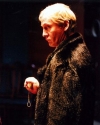
2. Viktor Verzhbitsky as Zavulon (from Dnevnoi Dozor, aka Day Watch, 2006, directed by Timur Bekmambetov)
Day Watch is the American title for the second installment in the Russian film trilogy based on the novels by Sergey Lukyanenko. The films involve the epic struggle between two groups of magical beings–the Day Watch and the Night Watch–who must maintain a balance between their two forces or the world will be destroyed in typical apocalyptic fashion. I’m sure that purists or hardcore fans of the film will tell me that Zavulon, the enigmatic leader of the Day Watch, is not a proper vampire. But, then again, there’s really no such thing as a proper vampire. They’re all loosely based on diverse folklore, fiction, and fantasy. Besides, Zavulon is undead, he commands an army of traditional vampires, and he’s got spooky and sinister powers. That’s close enough in my book. These films are a sensation in Russia, but are also gaining a much-deserved international audience. I especially admire the purity these films bring to the vampire tradition. They feature good (day) versus evil (night) with a necessary balance between them, as represented by the hazy, twilight middle ground between them called “the gloom” from which both groups draw their power. One could easily read this as a political metaphor for a post-Soviet Russia lost in a cultural mire as it tries to reestablish its direction and role in the world. But perhaps it’s best to simply approach the films as an entertaining, open-ended, and well-crafted allegory for the opposing forces that animate the human condition.
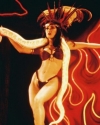
1. Salma Hayek as Santanico Pandemonium (from From Dusk Till Dawn, 1996, directed by Robert Rodriguez)
I’ll admit that aside from Salma Hayek, I didn’t care much for From Dusk Till Dawn the first time I saw it. The plot is a mess, the dialogue is often clichéd, and the vampires quickly become cartoonish. But something prompted me to try it again and I realized that this was more than a humble vampire flick. From Dusk Till Dawn is part of a revolution in film-making that had been in the works since the early 90s. Tarantino and Rodriguez took art house cinema away from the stiff pretenses of high brow culture and retrofitted it back to the seedier, more fluid aspects of the low brow. It’s not surprising that Rodriguez would recruit a horde of beer-drinking, strip-teasing, hell-raising vampires to help him do so. After all, vampires originate in folk tales and peasant culture, but their myth and imagery can be shaped to suit countless ends. They’re perfect for the screen in this regard. Tarantino, who co-wrote From Dusk Till Dawn, employs this to explore the hybrid nature of the medium he and Rodriguez so very much love. This film is part buddy movie, part action film, part vampire flick, with heavy doses of b-grade exploitation and camp thrown in as well. It makes for a fun mixture. And Salma Hayek is smoking hot. But she’s more than mere eye-candy. The fact that she turns so quickly from sultry vixen to demonic beast attests to the strange attraction that vampires have for those of us who love them. They represent our darkest fears of the monstrous, but also our deepest fantasies about having the power to do what we want, as well as being rendered powerless by something so exotic. Vampires, in other words, are the perfect cinematic vehicles because they represent all of those liberated, seductive, grotesque, and secretly attractive aspects of ourselves that we love to see on screen.








6 Responses to Jon’s 10 Favorite Vampires
Subscribe Without Commenting